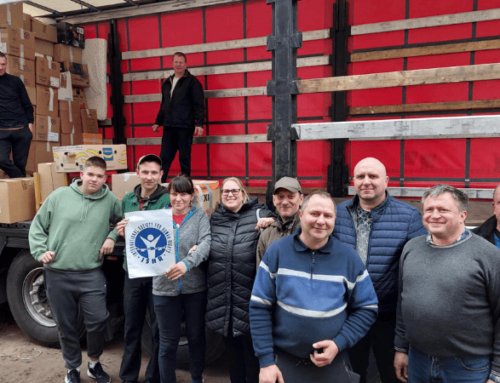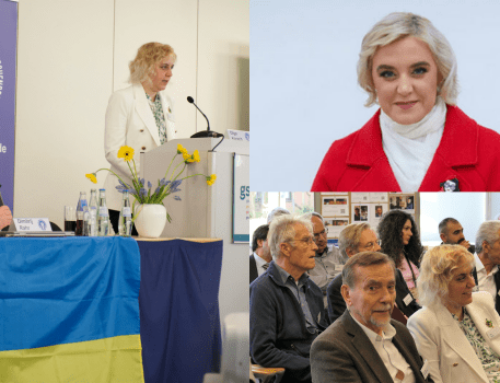Seminar on disinformation in Gagauzia

Picture No. 1. On entrance to Comrat – the capital of Gagauzia
On August 24, the Moldovan section of the International Society for Human Rights (ISHR) held a training seminar in Gagauzia as part of the international project “Mass Media, Opinion Formation, Human Rights”
The choice of venue for the seminar is due to the unique situation that has historically developed in this region.
The autonomous territorial entity of Gagauzia was ultimately enshrined in the constitution of Moldova in 1999. Although Gagauzia, as well as Transnistria, declared independence in the 1990s and expressed its desire to remain in the USSR, and then in the failed Union of Sovereign States (USS) and even for some time was the unrecognized state – the Republic of Gagauzia, its problems were resolved relatively peacefully in contrast to Transnistria.
In December 1994, the Parliament of Moldova adopted the Law on the Special Legal Status of Gagauzia (Gagauz-Yeri), which endowed the region with compact residence of the Gagauzians with autonomy rights. On July 22, 1995, the Vulcanesti, Comrat and Ceadir-Lunga regions became the internal regions of Gagauzia, however, the boundaries of the regions changed after the referendum held in the above villages, as well as of the neighboring regions Basarabeasca and Taraclia.
Many European human rights organizations have recognized Gagauzia as a successful example of resolving local national conflicts for other countries.
In the 2000s, Turkey provided significant assistance to Gagauzia.
Since the second half of the 2000s, political tensions between the authorities of Gagauzia and Chisinau have increased.
On February 2, 2014, the authorities of the autonomous republic held a referendum, during which 98 percent of the population voted in favor of the “deferred/postponed status of autonomy”, which gives it the right to secede from Moldova in case it loses its independence. Moldovan authorities declared the referendum unlawful and its results – null and void.
In Avdarma, a picturesque Gagauz village located 15 km from Comrat, a seminar was held at the “Avdarma” business center organized by the International Society for Human Rights concerning the disinformation in the media space of Moldova.

Picture No. 2. Memorial sign at the entrance to Avdarma.
It is worth noting that the Avdarma village is a unique village in Moldova. In this village, in 2018, at the general gathering of villagers, the nineteenth of October was approved as a “Memorial Day for the Victims of the Famine of 1946-1947”. The date of October 19 was chosen because on this day in 1946, for the first time, an official letter was sent from Comrat to the authorities of the Central Committee of the Communist Party of Moldova that people were dying of famine. Those people who signed this letter were repressed.
And only this year this day was recognized at the level of the whole Gagauzia. A monument was erected in honor of those who died of famine in Avdarma.
According to historians, as a result of the famine of the 1946 – 1947s, which became widespread in the south settlements of the MSSR, up to a third of the Gagauz population died.

Picture 3. Monument “Acı köşesi” in memory of the victims of the famine of the 1946-1947s.

Picture 4. Monument in Comrat in memory of the victims of political repressions during Stalin’s day.
Since 1998, the first newspaper in the Gagauz language “Ana Sözü” has been published in Gagauzia.
Such newspapers as “Hakikatın sesi”, “Meydan” and the magazines “Sabaa yıldızı” and “Gagauz dili hem literaturası” are also currently being published in the Gagauz language.
The Gagauz public television and radio broadcaster is the Teleradio of Gagauzia (Gag. Gagauziya Radio Televizionu kulesi – GRT), which hosts its programs in three languages: Gagauz, Russian and Moldavian. Some other television channels broadcast along with GRT, such as for example Achik TV (Acik TV).
The region has the following news portals:

Picture 5. Poster on a Street of Comrat. Advertising of the news portal which is in the confidence of the residents of Moldova.
The seminar was attended by local journalists, the director of Gagauz television, deputy mayors and mayors, as well as local Mayor’s office advisers of the cities neighboring with Comrat.
During the seminar there was presented information on the situation in the Moldovan media space and the engaged mass media, which belong nowadays to the oligarchs or political groups.

Picture 6. An example of manipulation in the Moldovan mass media. The speech of Prime Minister Maia Sandu in Gagauzia was mounted/doctored as if being filmed on the background of the Russian flag. Although in fact there was a flag of Gagauzia.
Unfortunately, in recent years, a large number of media outlets have appeared in Moldova that are engaged in brazen propaganda.

Picture 7. An example of a fake news portal that is popular and trusted.
The lecturers of the seminar gave examples of how the manipulations on the information portals take place, and how, deriving political benefits, fake news can discredit opponents and mislead the great masses of population.
The mass media actively use the language of hatred and apply technologies to incite ethnic hatred, dividing the society into separate unfriendly communities.
Very often, news portals take advantage of the fact that they incorrectly translate some information from Romanian into Russian and vice versa. And this also leads to distortions in the information presentation.
An active exchange of views took place within the framework of the event.
The seminar participants expressed the idea that such seminars should be introduced as a special course in schools and higher educational institutions of the country.
#CivilSocietyCooperation








Leave A Comment